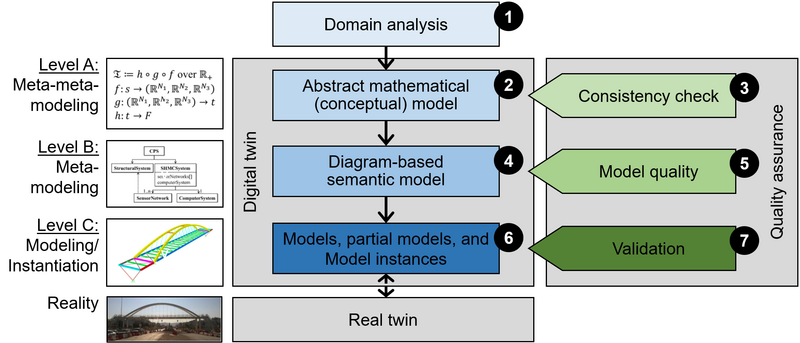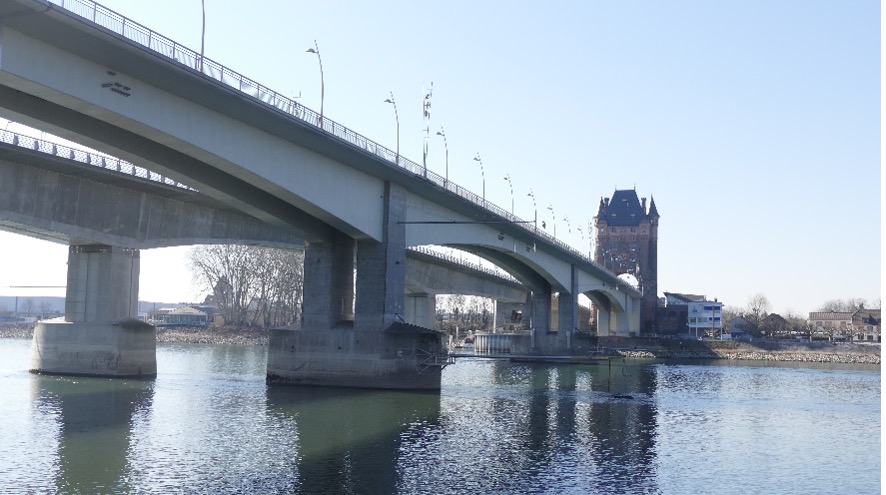Quality assurance of digital twins based on mathematical abstraction and tangle-based blockchain architectures
The digital twin concept has matured into a crucial cornerstone of many engineering disciplines since the end of the last century. Digital twins in civil engineering, however, are usually tailored to specific use cases, due to the unique character of civil engineering structures, or to specific subsystems of structures (e.g. structural subsystem, mechanical subsystem). The uniqueness of digital twins in civil engineering, the complex communication networks, and the heterogeneity of interfaces and models comprising the digital twins result in a lack of interoperability and objective quality assurance strategies. To improve quality and fully exploit the potential of digital twins in civil engineering, a clear mathematical understanding of the semantic structure of digital twins is required, which will provide formal concepts for quality assurance (including consistency checks, verification, and validation) of digital twins.
The project aims to provide a methodology to enable reliable quality assurance of digital twins in all design phases and at all levels of abstraction from which the design phases will pass – from creating abstract, conceptual models to implementing specific, practical applications. In the proposed project, the focus is placed on digital twins for infrastructure, although all approaches proposed in this project will be generally applicable. First, a domain analysis for taxonomic representation of digital twins will be performed to appropriately describe concepts and entities relevant to digital twins. Next, the work program is devoted to three levels of abstraction. On each level, (i) modeling concepts and (ii) approaches towards quality assurance of these modeling concepts will be proposed (Figure 1).
The modeling concepts will couple abstract mathematical approaches based on relational algebra, categorical ontology protocols, and type theory (“meta-metamodeling”), diagrammatic semantics that are easily comprehensible by engineers (“metamodeling”), and engineering models established in numerical analysis and building information modeling (“modeling”). The approaches towards quality assurance are essentially based on an abstract mathematical description, utility-based metrics, and a tangle-based blockchain architecture, introduced to validate the digital twins during their lifetime.
Contact
Publications
Peer-Reviewed Journal Paper
- Peralta, P., Ahmad, M. E., & Smarsly, K. (2023). Printing information modeling (PIM) for additive manufacturing of concrete structures. Applied Sciences, 13(23), 12664.
- Peralta, P., Ahmad, M. E., Al-Zuriqat, T., Chillón Geck, C., Al-Nasser, H., Dragos, K., Chmelnizkij, C., & Smarsly, K. (2025). Digital twins in civil engineering. Journal of Building Engineering (submitted).
Konferenz und andere VÖ
- Naser Eddin, N., Peralta, P., Al-Nasser, H., & Chillón Geck, C. (2023). A sustainable wireless sensor system for water quality monitoring. In Proceedings of the 34th Forum Bauinformatik, Bochum, Germany, 09/06/2023.
- Al-Zuriqat, T., Peralta, P., Chillón Geck, C., Dragos, K., & Smarsly, K. (2023). Implementation and validation of a low-cost IoT-enabled shake table system. In Proceedings of the 14th International Workshop on Structural Health Monitoring (IWSHM), Stanford, CA, USA, 09/12/2023.
- Vollmert, J., Peralta, P., & Tandon, A. (2024). Monitoring and simulation of robot kinematics for clay printing based on digital twins [Monitoring und Simulation von Roboterkinematik basierend auf digitalen Zwillingen für den Lehmdruck]. In Proceedings of the 35th Forum Bauinformatik, Hamburg, Germany, 09/18/2024.
- Vollmert, J., Peralta, P., Tandon, A., Harder, T. L., Al-Nasser, H., & Smarsly, K. (2024). Digital-twin-based monitoring and simulation of robot kinematics for clay printing. In Proceedings of the 15th European Conference on Product and Process Modeling (ECPPM), Dresden, Germany, 09/11/2024.
- Smarsly, K., Peralta, P., Dragos, K., Ahmad, M. E., Al-Zuriqat, T., Chillón Geck, C., & Al-Nasser, H. (2024). A multivocal literature review of digital twins, architectures, and elements in civil engineering. In Proceedings of the 11th European Workshop on Structural Health Monitoring (EWSHM), Potsdam, Germany, 06/10/2024.
- Smarsly, K., Ahmad, M. E., Peralta, P., Al-Zuriqat, T., Al-Nasser, H., Dragos, K., & Chillón Geck, C. (2024). Digital twins, architectures, and elements in civil engineering – A multivocal literature review. In Proceedings of the 20th International Conference on Computing in Civil and Building Engineering (ICCCBE), Montréal, Canada, 08/25/2024.
- Hartmann, S., Al-Zuriqat, T., Peralta, P., Valles, R., Gölzhäuser, P., Al-Hakim, Y., Mackenbach, S., Klemt-Albert, K., & Smarsly, K. (2024). Digital twins for sewer systems maintenance: A systematic literature review. In Proceedings of the 24th International Conference on Construction Applications of Virtual Reality (CONVR), Sydney, Australia, 11/04/2024.
- Al-Nasser, H., Ahmad, M. E., Peralta, P., Chillón Geck, C., Al-Zuriqat, T., Dragos, K., & Smarsly, K. (2024). Digital twin architectures in civil engineering: A systematic literature review. In Proceedings of the 15th Fachtagung Baustatik – Baupraxis, Hamburg, Germany, 03/04/2024.
- Al-Zuriqat, T., Noufal, M., Peralta, P., Dragos, K., & Smarsly, K. (2025). Automated defect detection in fused filament fabrication coupling deep learning and computer vision. In Proceedings of the 2025 European Conference on Computing in Construction (EC3), Porto, Portugal, 07/14/2025 (accepted).
- Peralta, P., Al-Zuriqat, T., Burse, B., Söbke, H., & Smarsly, K. (2025). Blockchain-based secure archiving of sensor malfunctions in structural health monitoring systems. In Proceedings of the 2025 European Conference on Computing in Construction (EC3), Porto, Portugal, 07/14/2025 (accepted).
- Peralta, P., Al-Zuriqat, T., Noufal, M., & Smarsly, K. (2025). Automated defect detection in clay printing. In Proceedings of the 42nd International Symposium on Automation and Robotics in Construction (ISARC), Montreal, Canada, 07/28/2025 (accepted).
- Smarsly, K., Chmelnizkij, A., Dragos, K., Peralta, P., Al-Zuriqat, T., Ahmad, M. E., Chillón Geck, C., Peralta, P., & Seitz, L. (2025). Decision making in structural health monitoring using large language models. In Proceedings of the 15th International Workshop on Structural Health Monitoring (IWSHM), Stanford, CA, USA, 09/11/2025 (submitted).
- Vollmert, J., Peralta, P., Alatassi, A., Chmelnizkij, A., & Smarsly, K. (2025). Towards structural health monitoring of clay-printed structures. In Proceedings of the 13th International Conference on Structural Health Monitoring of Intelligent Infrastructure (SHMII), Graz, Austria, 09/01/2025 (submitted).






